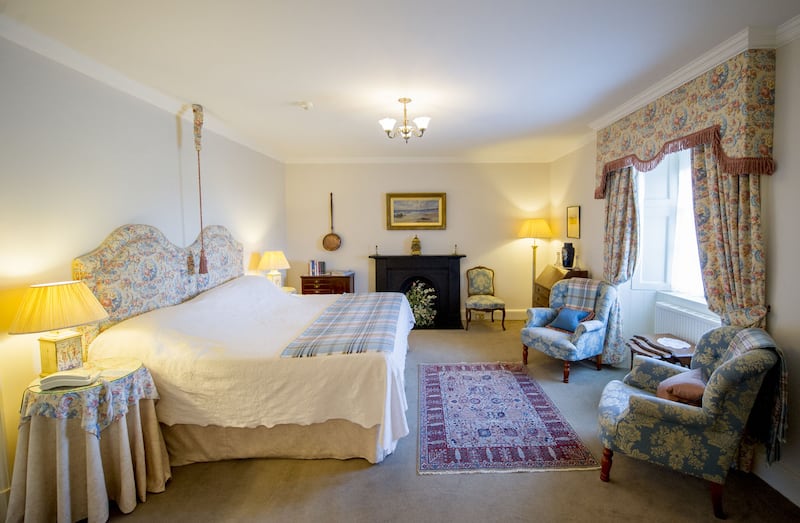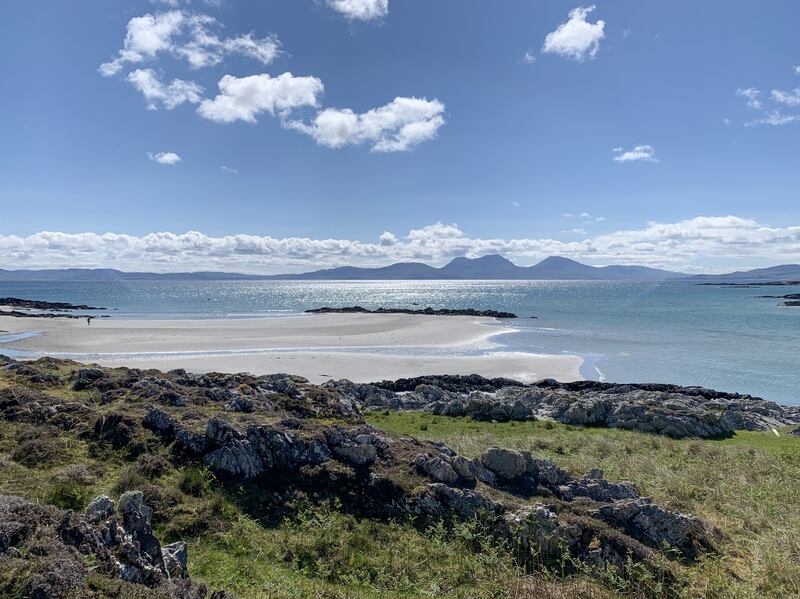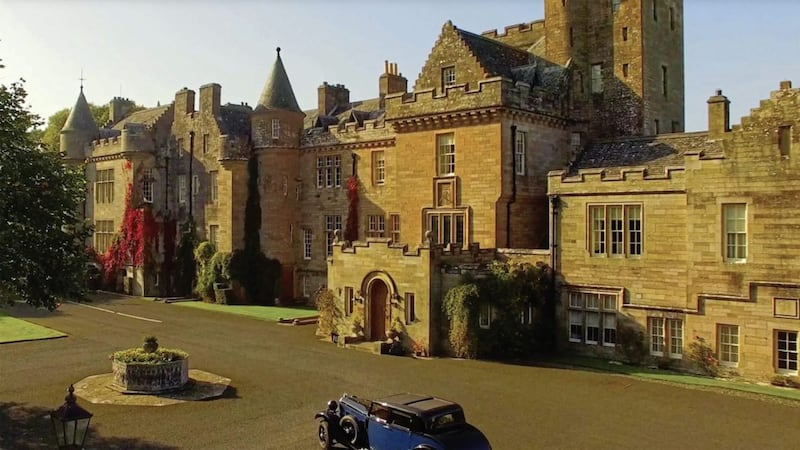"IGNORE the sat nav,” we were warned. “It will only get you lost. Just follow our directions and you’ll find us.”
The sat nav, which we had on anyway, led us to an old rusted gate. The inference being to leave your modern-day distractions behind. So instead we followed the directions that Jenny, our point of contact, had sent us – you would need to because there are no signposts to point the way. Such is the exclusivity of Glenapp Castle – only invited guests may enter. As the rain and mist set in we felt like characters in an Agatha Christie story as we announced ourselves at the gatehouse and even more so as the late 19th Century baronial-style stately home came into view.
This really is a bolthole – shrouded by forest and nestled in the glen at Ballantrae in Ayrshire, it is invisible from the road and now even the shore as a wall of mature trees shields guests from prying eyes. And once settled within the confines of the 36-acre grounds there is really no reason to leave.
We were greeted by a friendly staff team. We signed the guest book and a young man took our bags. The intimate hallway was lined with riding boots and wellies, tennis racquets, croquet mallets and umbrellas for the use of guests – this country estate, provides all the pursuits expected of such.
Ironically, what is most immediately striking is the quietness of the place. The 64 members of staff manage to only make their presence felt when needed. Tasks are carried out with next to no disruption to guests who are not expected to lift a finger here… except to dial 0.

The concierge led us to our room. Our bags were already waiting for us. We were staying in the premier second-floor room, the Countess of Inchcape. All rooms, of which there are 17, have names rather than numbers and each is individually decorated in period style.
Ours was a bright and sunny room and the en suite was also in keeping with the Victorian/Edwardian décor. The TV and telephone were the only clues that we were living in the 21st century.
As the wind whipped through the forest and the rain enfiladed the windows the temptation was to soak in the free-standing bath or take a nap on the sumptuous, king-size canopied bed. But I was eager to sample the vast array of whiskies on offer and so after freshening up we headed down to the drawing room for pre-dinner drinks.
A familiar face took our wine order as we enjoyed a delicate trio of canapés. We were then led into the cosy dining room for our six-course gastronomic adventure, and seated at a beautiful Georgian window, from where, our waiter assured us, we would normally be able to see Ireland. The weather was irrelevant this weekend. We were here to unwind and there is a reassuring soothingness in inclement weather in surroundings such as these.

Our food was prepared in the kitchen of David Alexander, who came on board as executive chef in 2016. The food not only showcased the chef’s talent but also the very best of local produce – some of which is cultivated on the estate.
After dinner we moved back to the drawing room for coffee and petit fours before melting into a comfortable sleep with a whisky nightcap.
In the morning the mist and clouds cleared revealing a stunning clear sea view as promised in the brochure.
Breakfast is served in the breakfast room until 10:45am. It was another multi-course delight and my husband got the haggis that he’d been craving.
The concierge then led us out into the lawn for our prearranged archery session. As we walked he informed us that the regular falconry display would not be happening today. “Shame,” although probably just as well since a few of my arrows went awry.
The archery is arranged on a private basis and like some of the activities at the castle there is a charge. In fact there are so many activities at the castle, ranging from clay-pigeon shooting or a Hebridean sea safari to tennis, boules or croquet, that it would be perfectly easy to spend a long weekend holed up at Glenapp. However, it was a beautiful day and, this being my first time in Scotland, I wanted to see something of the surrounding area.

We had travelled to Scotland with Stenaline. Travelling by ferry afforded us the luxury of bringing our own car and if you want to start your journey in style and comfort then you could upgrade to the Stena Plus Lounge – around £8 per person. Even for the ordinary punter sailing is still a lot more comfortable and relaxed than flying and you don’t have to restrict yourself luggage-wise.
Our crossing to Scotland and back was very smooth and it can be enjoyed from the comfort of the restaurant, bar or coffee lounge. But if you want to pamper yourself there is also the Hygge recline lounge and the Nordic Spa. For families, an arcade, cinema and a designated kids’ zone will keep children entertained throughout the journey. The sailing from Belfast to Cairnryan takes around two and a half hours, depending on conditions, and then it’s just a 20-minute drive to Ballantrae.
On the advice of the Glenapp staff we drove south to the pretty seaside village of Portpatrick, a former ferry destination. A 40-minute drive along the coast and through countryside and we arrived at this port on the west coast of the Rhins of Galloway. Now the only boats in the harbour are pleasure boats and fishing boats. The seafront is dotted with busy pubs and restaurants but Portpatrick has retained a rural charm. It has resisted the temptation to capitalise heavily on tourism, relying on the simplicity of its cliff walks, history, fresh seafood and friendly pubs to entice visitors.
After a walk round the harbour watching the black guillemots dive for fish, we had a drink at the Waterfront bar and then walked the short distance to the obliging Connor’s bistro where we enjoyed a reasonably-priced lunch of lobster thermidor and scallops. The lobster, like most of the seafood at Portpatrick, is locally caught.
We then explored the cliff walks, the ruins of 16th century Dunskey Castle and visited one of the village’s few souvenir shops.
Back at the castle we took the opportunity before dinner to see something of the gardens and took a walk through the walled garden that also houses the glasshouse and Victorian tearoom.
The castle menu changes daily and it was a lovely surprise coming in from a busy day to find that evening’s new menu waiting for us in our room.
After dinner we took our coffee in the library for a game of chess. The history of the castle is most evident here as the books are a veritable timeline of the lives and pursuits of the former owners and famous guests, from aviator Elsie McKay to Winston Churchill, a portrait of whom judges visitors as they enter the library but you’ll have to find out all about them for yourself.
Ayrshire is popular with golfers and fishermen and Glenapp is within an hour of four championship golf courses. Fishermen can hire the castle boat for sea excursions or alternatively the nearby Stinchar River provides excellent salmon and fly fishing.
The next morning was another sunny day and we decided to visit the Victorian tearoom before leaving. But another walk was needed to make room for cake.
With some time to pass before the ferry we headed north up the coast towards Girvan. The coastal drive is impressive and we stopped along the way to take in the view of Aisla Craig, a 1,114ft volcanic plug that rises out of the Firth of Clyde. Once a refuge for persecuted Catholics the island now gives sanctuary to a 400,000-strong colony of gannets.
I’m sorry to say that Girvan was less impressive. With amusement arcades, cafes, boat rides, a leisure centre, play park, pedalos on the bustling promenade and a very decent beach it’s understandably popular with families and day-trippers. However, take a few steps inland and it is nothing but a ghost town and very much in need of some TLC. But ours was a fleeting visit – just enough time for an ice-cream and a stroll along the pier.
We had already said our thanks and reluctant goodbyes to general manager John Orr and the staff. We would have loved to linger a while, like the American family we met who had extended their stay, but it was time to return to the real world. For many visitors it isn’t their first visit and Glenapp is a home from home, because here there are no customers… only guests.
GETTING THERE
Belfast to Cairnryan Stenaline: five sailings daily between the two ports. We travelled on a Friday with a car mid-afternoon and returned Sunday early evening (price £368 for two adults). However, kids go free, and midweek and off-peak time sailings are cheaper. Info and booking at stenaline.co.uk
FACT FILE
:: Glenapp was built by David Bryce for James Hunter – the deputy lord lieutenant of Ayrshire in 1870
:: Taken over by P&O shipping heir James McKay in 1917, father of actress and aviator Elsie McKay (stage name Poppy Wyndham).
:: Restored in 1994 by Fay and Graham Cowan, in 2015 the hotel was purchased by Paul and Poppy Szkiler.
:: The luxury 5 red star castle is now part of the Relais & Chateaux global hotel group and was winner of Independent Hotel of the Year in the 2019 CIS Excellence Awards.
:: Room prices range from £395 for ‘standard room’ one-night bed and breakfast to £795 per night for the master suite with 6-course dinner, bed and full Scottish breakfast. Book early (60 days in advance) to enjoy a 15 per cent discount on all room rates. See glenapp.com for more




